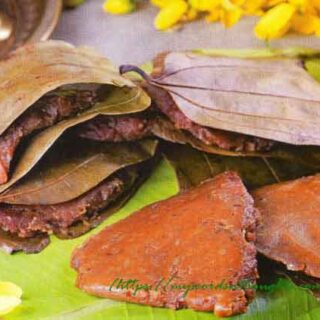For Thrissur people, Pulikali is another name of their Onam celebration. After Thrissur Pooram, the cultural capital of Kerala is quite famous for Pulikali. When men disguised themselves as leopards and tigers conquer the whole streets of main town by jingling bells tied around their waists, Thrissur people cheer the moments. The visual of colourful tigers with tiger-figures drawn on their fat bellies is a delight to watch, and every year more than 500 tigers participate in the cultural event.
Pulikali of Thrissur owns a history of more than 7 decades

When you cheer with ‘tigers’ of Thrissur during Onam season, have you ever thought what the history behind it is? When did it actually start? Pulikali backs to about 7 decades when it was started, and since then certain rules have been made on how this entertaining Onam sport is to be displayed.
Tigers dance on Thrippuda Thaalam
Pulis definitely own a rhythm and they dance with Chendamelam though audience rarely notices it. ‘Kaayalarikath Vala Erinjappol’ – the iconic song of Malayalam movie Neelakuyilis based on this rhythm. It also follows a series of clear cut dance steps. Tigers bend their hands forward and raise them till their chests with closed fists – it’s the general step followed in the sport. When they put one step forward using right leg, left hand should rise up forward and the procedure continues.
Once Tigers used to reach courtyards of Thrissur homes a quarter-century ago
 Pulikali, also known as Kaduvakali in certain regions is associated with Onam celebrations. On Thiruvonam day, usually after lunch, one or more men disguised as tigers used to visit homes and dance at courtyard and around pookkalams. A hunter usually accompanies them, and dancing tiger escapes from hunter using his tricks. That’s how pulikali is associated with glorious nostalgic years of yesterdays. Now more than an entertaining sport, it has turned expensive and often seen as a part of tourism promotion of Kerala during Onam season.
Pulikali, also known as Kaduvakali in certain regions is associated with Onam celebrations. On Thiruvonam day, usually after lunch, one or more men disguised as tigers used to visit homes and dance at courtyard and around pookkalams. A hunter usually accompanies them, and dancing tiger escapes from hunter using his tricks. That’s how pulikali is associated with glorious nostalgic years of yesterdays. Now more than an entertaining sport, it has turned expensive and often seen as a part of tourism promotion of Kerala during Onam season.
In those heydays of joint families, tigers used to visit homes and they earned cash for entertaining audience. Play starts only after all family members reach the front side of the home. As soon as members hear chendamelam, they start gathering at courtyard and front side. Procedure starts by giving one rupee note to Puli team. It is usually placed on soil ground, in a raised position. In those days Kerala homes didn’t own concrete courtyards. One member of the group will pick the one-rupee note using his mouth, lying on ground. An expert can even pick the note using eye lids! This procedure is called – Belt Adikkuka in local terms.
Normally 7 tigers form a group. They also make a pookuda (a small bag made of leaves to carry flowers) to bring more colours to the festival season. A few more games are also associated with it. A pot made of Panamb is tied to a bamboo stick of length 10 feet. The pot decorated with small cut pieces of colour papers is tied upside down. They swing this pot like a sport, similar to tied pot during Janmashtami occasion. On rare occasions, the team gets new dress, and they tie below it. The team normally gets only a small amount, enough to pay for instrument players and small celebrations. Yet till 25 years ago, such sights were common in rural Kerala where Pulikali team used to visit every home.
The regular play at Naduvilaal for the past 60 years
 Pulikali is normally conducted on the fourth Onam day as a part of Onam celebrations, and the same day at 3 pm, a few small groups regularly reach Naduvilaal for the past 60 years. It’s quite common that this sport ends in small conflicts and indifferences too. As if to commence this sport, damanam of Valiya Palli church used to be taken as a procession in bullock cart around Thekkumkad ground, the heart of Thrissur main town by Puli team. The team arranged money after playing in local areas and houses on Thiruvonam, Avittam, Chathayam and till noon of Pooruruttathi day. They never collected money by other means. The team reaches Naduvilaal with what they get from homes.
Pulikali is normally conducted on the fourth Onam day as a part of Onam celebrations, and the same day at 3 pm, a few small groups regularly reach Naduvilaal for the past 60 years. It’s quite common that this sport ends in small conflicts and indifferences too. As if to commence this sport, damanam of Valiya Palli church used to be taken as a procession in bullock cart around Thekkumkad ground, the heart of Thrissur main town by Puli team. The team arranged money after playing in local areas and houses on Thiruvonam, Avittam, Chathayam and till noon of Pooruruttathi day. They never collected money by other means. The team reaches Naduvilaal with what they get from homes.
As time passed by when lorries reached Thrissur town, the procession started in lorries, and instead of slim figures, fat tigers earned popularity. The persons with good physique were chosen for the sport. Pictures of tiger and leopard faces were drawn on the stomach of two or three among them and made them sit on the top of lorry. When the lorry reaches Naduvilaal, they get down of the vehicle line by line and start dancing. It’s at Naduvilaal where Pulikali actually started 60 years ago, and now gained popularity as an Onam sport across Thrissur. The participant with best costume and perfectness gets the opportunity to break coconut at Naduvilaal.
History tells, more than 20 groups have reached in the past time at Naduvilaal to play the sport. The participants reached from different zones of Thrissur town. Teams – Padinjare Kotta (West Fort), Kottapuram and Thurkuman Gate (Over Bridge) from West, Veliyannoor and Kokala teams from South and alternate teams – West Fort, Chembukavu and Mailipadam from West presented their Pulikali teams. The spirit of Pulikali is high at North side which includes Viyyur, Peringavu, Patturaikkal, Chakkaamukku, Poonkunnam, Company Idavazhi, Thiruvambady, Naykanal, Remadevi Centre, Kuttamkulangara …. and thus it goes.
The sport on a pestle
It was quite common during the ages of pulling carts and bullock carts. Four persons – two each carry a pestle (Ulakka in Malayalam) on shoulders, and a participant disguised as tiger will climb on its top and displays his dancing talents. Similarly another group also forms, and the tiger on the top crosses his finger with the tiger on the first pestle group like a ladder. The teams reach the location in pulling carts. A special arrangement is made using bamboo sticks on the top of the cart and participants stand on the top swinging tied colour pots. The participants leave the place by sunset.
Dancing on pestle is displayed by different Pulidesams during annual Pulikali celebrations at Swaraj Road nowadays.
Old days of glorious tigers

Puli Kali of Thrissur
In those heydays all people irrespective of caste and creed used to participate in this Onam sport and do the makeup of tigers and leopards. They included some of the famous players such as Balan (Kuttankulangara), Kaattalan Porinju (West Fort), Mussolini (Patturaikal), Ganapathy Swami, Thiruthisaiv, Iyyakku Jose etc. Pulikali was never a competition then. Instead it was seen as a sport to celebrate harmony, prosperity and integration. Slowly the sport has branched into one of the biggest entertainments of Onam season.
Pothottapuli is also associated with the season. On the 16th day of Pulikali, tigers enter streets once again. This time they use the remaining portions of paints to do the makeup, things left after the big Pulikali festival. Onam celebrations finally end with Pothottapuli which tests the potential of ‘Urukkal’.
Pen Puli – The new added element to Pulikali
Year 2016 Onam celebration witnessed a major change in Pulikali events. For the first time in the history of Pulikali, ladies participated in the event. A group of ladies wore specially designed dress, did extensive makeup and tied bells around their waists to participate in the event. When the group of female tigers entered the streets of main town, a history was rewritten.
Go through the gallery to read a few more interesting articles on fun, recreation, myths and traditions associated with Onam season. Here is the page link. Click on the images to read.

 Pulikali, also known as Kaduvakali in certain regions is associated with Onam celebrations. On Thiruvonam day, usually after lunch, one or more men disguised as tigers used to visit homes and dance at courtyard and around pookkalams. A hunter usually accompanies them, and dancing tiger escapes from hunter using his tricks. That’s how pulikali is associated with glorious nostalgic years of yesterdays. Now more than an entertaining sport, it has turned expensive and often seen as a part of tourism promotion of Kerala during Onam season.
Pulikali, also known as Kaduvakali in certain regions is associated with Onam celebrations. On Thiruvonam day, usually after lunch, one or more men disguised as tigers used to visit homes and dance at courtyard and around pookkalams. A hunter usually accompanies them, and dancing tiger escapes from hunter using his tricks. That’s how pulikali is associated with glorious nostalgic years of yesterdays. Now more than an entertaining sport, it has turned expensive and often seen as a part of tourism promotion of Kerala during Onam season. Pulikali is normally conducted on the fourth Onam day as a part of Onam celebrations, and the same day at 3 pm, a few small groups regularly reach Naduvilaal for the past 60 years. It’s quite common that this sport ends in small conflicts and indifferences too. As if to commence this sport, damanam of Valiya Palli church used to be taken as a procession in bullock cart around Thekkumkad ground, the heart of Thrissur main town by Puli team. The team arranged money after playing in local areas and houses on Thiruvonam, Avittam, Chathayam and till noon of Pooruruttathi day. They never collected money by other means. The team reaches Naduvilaal with what they get from homes.
Pulikali is normally conducted on the fourth Onam day as a part of Onam celebrations, and the same day at 3 pm, a few small groups regularly reach Naduvilaal for the past 60 years. It’s quite common that this sport ends in small conflicts and indifferences too. As if to commence this sport, damanam of Valiya Palli church used to be taken as a procession in bullock cart around Thekkumkad ground, the heart of Thrissur main town by Puli team. The team arranged money after playing in local areas and houses on Thiruvonam, Avittam, Chathayam and till noon of Pooruruttathi day. They never collected money by other means. The team reaches Naduvilaal with what they get from homes.














Actually i don't know anything about pulikali but after going through your blog i got a clear picture about thrissur pulikali. Thank you so much for sharing this awesome information